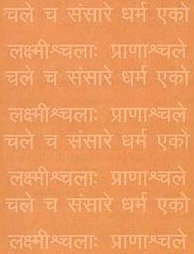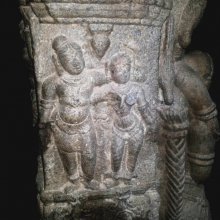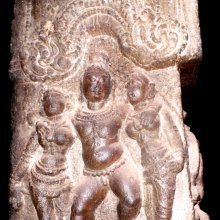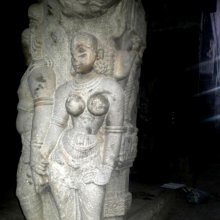Gopika, Gōpikā, Gopikā: 12 definitions
Introduction:
Gopika means something in Hinduism, Sanskrit, Marathi, Hindi. If you want to know the exact meaning, history, etymology or English translation of this term then check out the descriptions on this page. Add your comment or reference to a book if you want to contribute to this summary article.
Images (photo gallery)
(+10 more images available)
In Hinduism
Vaishnavism (Vaishava dharma)
Source: Pure Bhakti: Bhajana-rahasya - 2nd EditionGopikā (गोपिका) or Gopī refers to:—A cowherd girl or woman of Vraja. (cf. Glossary page from Bhajana-Rahasya).

Vaishnava (वैष्णव, vaiṣṇava) or vaishnavism (vaiṣṇavism) represents a tradition of Hinduism worshipping Vishnu as the supreme Lord. Similar to the Shaktism and Shaivism traditions, Vaishnavism also developed as an individual movement, famous for its exposition of the dashavatara (‘ten avatars of Vishnu’).
Vedanta (school of philosophy)
Source: Shodhganga: Siva Gita A Critical StudyGopikā (गोपिका) or Gopikāgītā refers to one of the sixty-four Gītās commonly referred to in Hindu scriptures.—Gītā is the name given to certain sacred writings in verse (often in the form of a dialogue) which are devoted to the exposition of particular religious and theosophical doctrines. Most of these Gītās [i.e., Gopikā-gītā] originate from the Mahābhārata or the various Purāṇas.

Vedanta (वेदान्त, vedānta) refers to a school of orthodox Hindu philosophy (astika), drawing its subject-matter from the Upanishads. There are a number of sub-schools of Vedanta, however all of them expound on the basic teaching of the ultimate reality (brahman) and liberation (moksha) of the individual soul (atman).
Languages of India and abroad
Marathi-English dictionary
Source: DDSA: The Molesworth Marathi and English Dictionarygōpikā (गोपिका) [or गोपी, gōpī].—f (S) A female cowherd.
Source: DDSA: The Aryabhusan school dictionary, Marathi-Englishgōpikā (गोपिका) [-gōpī, -गोपी].—f A female cowherd.
Marathi is an Indo-European language having over 70 million native speakers people in (predominantly) Maharashtra India. Marathi, like many other Indo-Aryan languages, evolved from early forms of Prakrit, which itself is a subset of Sanskrit, one of the most ancient languages of the world.
Sanskrit dictionary
Source: Cologne Digital Sanskrit Dictionaries: Edgerton Buddhist Hybrid Sanskrit DictionaryGopikā (गोपिका) or Gopā.—(and Gopī), wife of the Bodhisattva: °kāya (gen.) Lalitavistara 235.21 (verse); °ke (voc.) 237.13 (verse); Mūla-Sarvāstivāda-Vinaya iv.233.17 (but in 234.14 Yaśodharā).
Source: Cologne Digital Sanskrit Dictionaries: Shabda-Sagara Sanskrit-English DictionaryGopikā (गोपिका).—f.
(-kā) A female cowherd, &c.: see gopaka.
Source: Cologne Digital Sanskrit Dictionaries: Aufrecht Catalogus CatalogorumGopīka (गोपीक) as mentioned in Aufrecht’s Catalogus Catalogorum:—and ācāryagopīka poet. [Sūktikarṇāmṛta by Śrīdharadāsa]
Source: Cologne Digital Sanskrit Dictionaries: Monier-Williams Sanskrit-English Dictionary1) Gopikā (गोपिका):—[from gopaka > go-pa] a f. ([gana] śivādi) a cowherd’s wife, cowherdess, [Bhāgavata-purāṇa x, 9, 14 f.]
2) [v.s. ...] a protectress, [Horace H. Wilson]
3) Gopika (गोपिक):—[from go-pa] m. the Mokṣaka tree, [Demetrius Galanos’s Lexiko: sanskritikes, anglikes, hellenikes]
4) Gopikā (गोपिका):—[from go-pa] b f. of paka q.v.
Source: Cologne Digital Sanskrit Dictionaries: Yates Sanskrit-English DictionaryGopikā (गोपिका):—(kā) 1. f. A milk-maid.
Source: DDSA: Paia-sadda-mahannavo; a comprehensive Prakrit Hindi dictionary (S)Gopikā (गोपिका) in the Sanskrit language is related to the Prakrit word: Goviā.
[Sanskrit to German]
Sanskrit, also spelled संस्कृतम् (saṃskṛtam), is an ancient language of India commonly seen as the grandmother of the Indo-European language family (even English!). Closely allied with Prakrit and Pali, Sanskrit is more exhaustive in both grammar and terms and has the most extensive collection of literature in the world, greatly surpassing its sister-languages Greek and Latin.
Hindi dictionary
Source: DDSA: A practical Hindi-English dictionaryGopikā (गोपिका):—(nf) see [gopī].
...
See also (Relevant definitions)
Starts with: Gopikagita, Gopikanta, Gopikasaras.
Ends with: Acaryagopika, Grihagopika.
Full-text: Gaupika, Gopaka, Govia, Gopikasaras, Kopikastiri, Acaryagopika, Gopi, Rasakkiritai, Kopikavacantam, Gopin, Grihagopika, Grihagolika, Gopikagita, Ranganem, Gopa, Kalama, Sakkapanha-sutta, Nila.
Relevant text
Search found 30 books and stories containing Gopika, Gōpikā, Gopikā, Gopīka; (plurals include: Gopikas, Gōpikās, Gopikās, Gopīkas). You can also click to the full overview containing English textual excerpts. Below are direct links for the most relevant articles:
Garga Samhita (English) (by Danavir Goswami)
Verse 1.17.41 < [Chapter 17 - Description of the Yogurt Theft]
Verse 1.14.37 < [Chapter 14 - The Liberation of Śakaṭāsura and Tṛṇāvarta]
Verse 2.21.23 < [Chapter 21 - The Rāsa-dance Pastime]
Hari-bhakti-kalpa-latikā (by Sarasvati Thkura)
Jarasandhavadha Mahakavyam (by Pankaj L. Jani)
Canto 3 - Lamentation of Gopikas
Part 2 - Translation of a Sanskrit Text < [Critical Introduction]
Pallava period (Social and Cultural History) (by S. Krishnamurthy)
Household Articles (a): Vessel < [Chapter 4 - Material Culture of the People]
Shoulder Ornaments < [Chapter 4 - Material Culture of the People]
Head-dress of Women (b): Cylindrica cap like Makuta < [Chapter 4 - Material Culture of the People]
Bhajana-Rahasya (by Srila Bhaktivinoda Thakura Mahasaya)
Text 2 < [Chapter 7 - Saptama-yāma-sādhana (Pradoṣa-kālīya-bhajana–vipralambha-prema)]
Text 18 < [Chapter 6 - Ṣaṣṭha-yāma-sādhana (Sāyaṃ-kālīya-bhajana–bhāva)]
Text 15 < [Chapter 5 - Pañcama-yāma-sādhana (Aparāhna-kālīya-bhajana–kṛṣṇa-āsakti)]
Erotism in 'Geeta Govinda' < [April 1967]
The Thousand Hoods < [April - June 1977]
Erotism in 'Geeta Govinda' < [April 1967]





